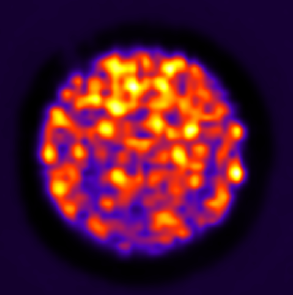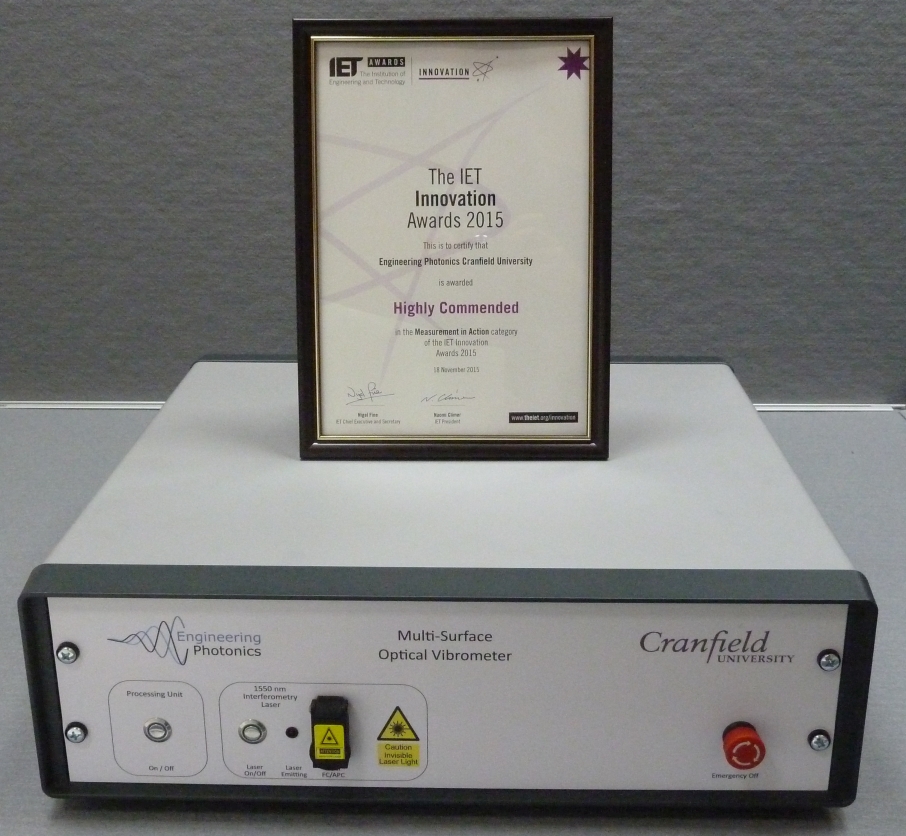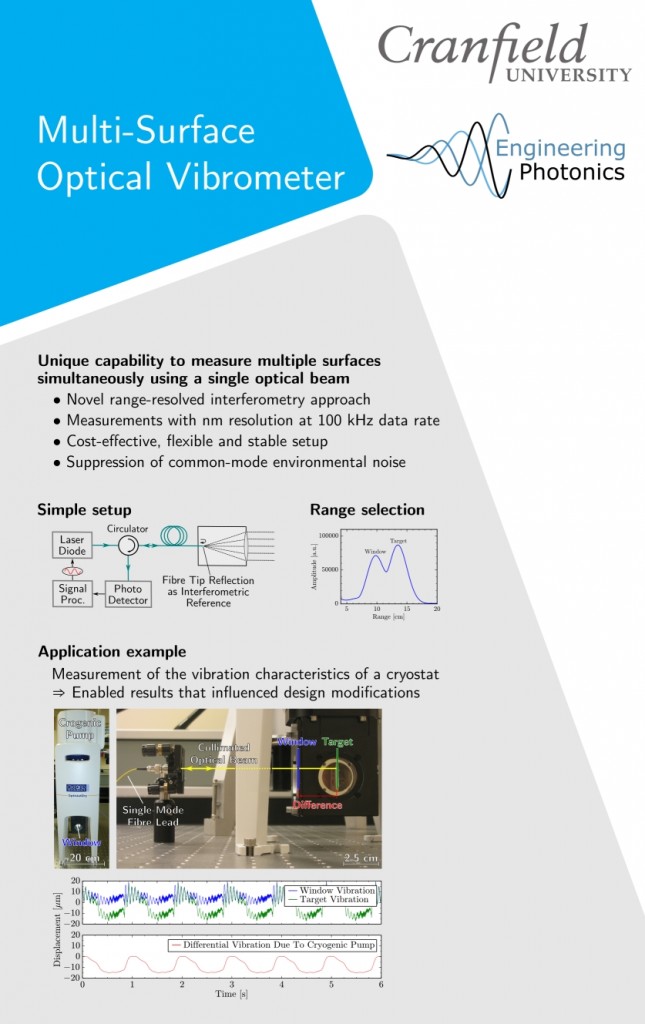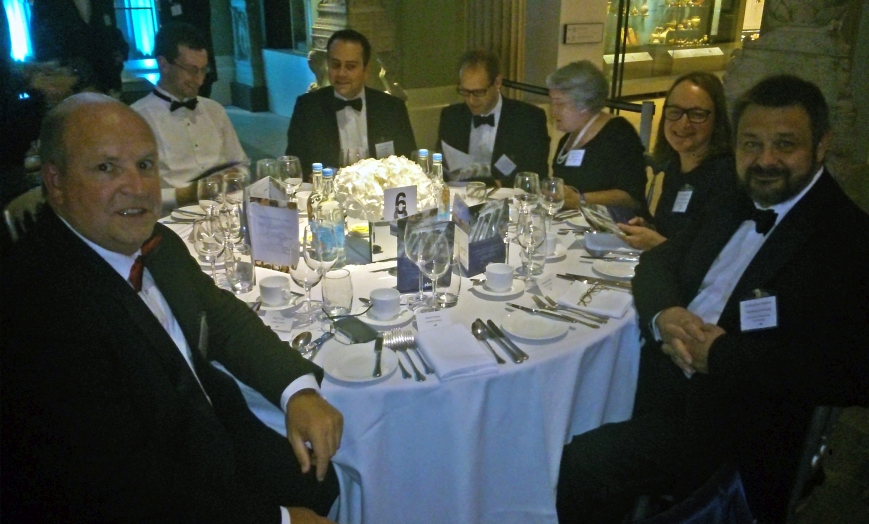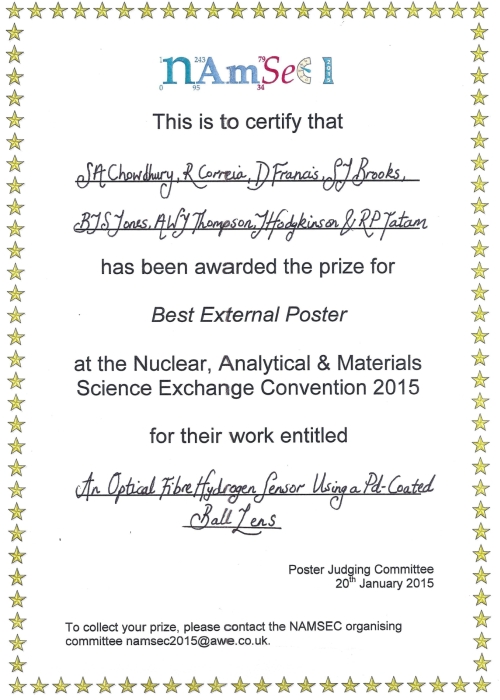previous next
Publication update – Mid-infrared laser light propagation in hollow waveguides
11th December 2015
Recently we published a paper in Applied Physics B describing our research into the propagation of mid-infrared laser light through hollow silica waveguides. The laser that we were using is a mid-infrared (7.8 μm) quantum cascade laser that is housed in a research platform based on a Cascade Technologies laser spectroscopy system. Hollow silica waveguides are narrow tubes made of silica which are internally coated with silver to allow infrared light to be guided along them. Their typical inner bore diameters range from about 300 μm to 1 mm and have lengths of up to 5 m. They are typically used for accurate guiding very high powered infrared laser beams, such as from CO2 lasers, for precise cutting applications, e.g. in surgery or in industrial machining. Our interest in them lies in the development of spectroscopic gas cells with very low volume and fast response times.
The paper featured in the Applied Physics B special issue covering the FLAIR 2014 conference. It modelling of the coupling coefficients using the overlap integral and validation of the modelling through the use of a thermal imaging camera to monitor the laser output from the waveguide. The results were quantitatively compared by using Fourier transform techniques to analyse the spatial frequency content of the observed speckle patterns. This was done to determine the most effective launch characteristics for different waveguides using our laser.
The paper is open access and can be freely downloaded –
Quantum cascade laser light propagation through hollow silica waveguides
D Francis, J Hodgkinson, B Livingstone* and R P Tatam
Applied Physics B 119(1), 75-86 (2015) – Open Access
*Cascade Technologies Ltd, Stirling, UK,
IET innovation finalists 2015
18th November 2015
The multi-surface vibrometry system developed by Engineering Photonics at Cranfield University was shortlisted for the IET Innovation Awards 2015 in the category “Measurement in Action”.
A summary description of our entry: “The innovation is a novel optical fibre laser-based instrument that permits non-contact measurement of displacement and vibration with nanometre resolution of multiple semi-transparent surfaces along the line of the laser beam. The instrument is low cost and robust and overcomes limitations of expensive commercial systems.”
For this occasion a group of four from Engineering Photonics (Thomas Kissinger, Tom Charrett, Stephen James and Ralph Tatam) travelled to the venue at the Brewery in London on the 18th of November 2015. Before the actual ceremony took place we were given the chance to present a live demonstration of the system running in the foyer at the Brewery. At times, all four of us were busy answering the questions of the ceremony guests. Unfortunately we did not win the award, nevertheless it was a memorable event and the possibility to exhibit the system running to such a large audience was truly worthwhile.
References:
- T. Kissinger “Range-resolved optical interferometric signal processing”, PhD Thesis, Cranfield University (2015).
- T. Kissinger, T. O.H. Charrett, and R. P. Tatam, “Range-resolved interferometric signal processing using sinusoidal optical frequency modulation”, Opt. Express 23(7), 9415-9431 (2015).
- T. Kissinger, T. Charrett, S. W. James, A. Adams, A. Twin, and R. P. Tatam, “Simultaneous laser vibrometry on multiple surfaces with a single beam system using range-resolved interferometry”, SPIE Optical Metrology, Munich, Germany, Proc. SPIE 9525-20, 7pp (2015).
Finalists in OBN awards – 2015
1st October 2015
 The DIABLO consortium was recently shortlisted for ‘best public-private collaboration’ in the Oxford Biotechnology Network (OBN) awards. The DIABLO (detection of infectious agents by laser optics) consortium consists of Cranfield University (Engineering Photonics and the former School of Health), Cascade Technologies, and Bedford Hospital. It was set up to research the use of mid-infrared spectroscopy to diagnose hospital based infections, specifically Clostridium difficile, and was funded by the Technology Strategy Board (now Innovate UK).
The DIABLO consortium was recently shortlisted for ‘best public-private collaboration’ in the Oxford Biotechnology Network (OBN) awards. The DIABLO (detection of infectious agents by laser optics) consortium consists of Cranfield University (Engineering Photonics and the former School of Health), Cascade Technologies, and Bedford Hospital. It was set up to research the use of mid-infrared spectroscopy to diagnose hospital based infections, specifically Clostridium difficile, and was funded by the Technology Strategy Board (now Innovate UK).
Our work involved the discovery of a suite of biomarkers for C-diff (Cranfield Health) and the development of novel gas cells using hollow waveguides that allow highly sensitive spectroscopy of very small volumes of gas (Engineering Photonics). The award ceremony was a black-tie event held at the Ashmolean museum in Oxford and was attended by Ralph, Jane and Dan from Engineering Photonics and Chris Walton from Cranfield Health. The award was won by Isansys and Birmingham Children’s Hospital for their groundbreaking development of wireless patient monitoring systems.
International conference on composite materials
July 2015
In July, Edmond Chehura travelled to Denmark to present his work on process monitoring of an all-composite tailcone using fibre-optic sensors at the 20th International Conference on composite materials (ICCM 20) in Copenhagen.

The Frederiksholm Canal in the center of old Copenhagen (© Jacob Surland).
Conference presentation
Monitoring the manufacturing process and the mechanical performance of a full-sized aircraft tailcone assembly made from all-composite material using embedded fibre optic sensors
E Chuhura, S W James, S E Staines, C Groenendijk+, D Cartie*, S Portet$, M Hugon$ and R P Tatam
+NLR, The Netherlands; *Coriolis Composite Technologies SAS, France; $Daher Aerospace, France;
Sahar Chowdhury wins Best External Poster competition at AWE
January 2015
Sahar Chowdhury’s work on hydrogen sensing using optical fibre ball lenses has been recognised by winning the Best External Poster competition at the Nuclear, Analytical and Materials Science Exchange Convention at the Atomic Weapons Establishment. The prize is a tour of AWE’s facilities near Aldermaston, Berkshire.
previous next

